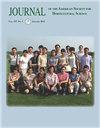Strigolactone and Ethylene Inhibitor Suppressing Dark-induced Leaf Senescence in Perennial Ryegrass Involving Transcriptional Downregulation of Chlorophyll Degradation
IF 1.1
4区 农林科学
Q3 HORTICULTURE
Journal of the American Society for Horticultural Science
Pub Date : 2021-03-01
DOI:10.21273/jashs04933-20
引用次数: 6
Abstract
Accelerated or premature leaf senescence induced by dark conditions could be associated with chlorophyll degradation and regulated by hormones. To study the effects of strigolactone (SL) on dark-induced leaf senescence and to examine the interaction effects of SL and ethylene on regulating dark-induced leaf senescence, plants of perennial ryegrass (Lolium perenne) exposed to darkness for 8 days were treated with a synthetic SL analogue (GR24), aminoethoxyvinyl glycine [AVG (an ethylene biosynthesis inhibitor)], or SL and AVG by foliar spray. Chlorophyll content, photochemical efficiency, electrolyte leakage, and ethylene production were measured. Expressions of genes associated with leaf senescence, SL biosynthesis and signaling, ethylene biosynthesis and signaling, and chlorophyll biosynthesis and degradation were determined. Foliar application of GR24 promoted leaf senescence in perennial ryegrass grown in darkness, and the intensity of action increased with the GR24 concentration. SL-accelerated leaf senescence was associated with the downregulation of four chlorophyll biosynthesis-associated genes and upregulation of four chlorophyll degradation-associated genes. AVG had functions counteractive to SL, suppressing dark-induced leaf senescence by downregulating chlorophyll degradation genes and SL synthesis genes. Our results suggested that SL and ethylene interactively regulated leaf senescence, mainly by controlling chlorophyll degradation induced by darkness in perennial ryegrass.独角麦内酯和乙烯抑制剂通过下调叶绿素降解转录抑制多年生黑麦草黑暗诱导的叶片衰老
光照条件下叶片加速或提前衰老可能与叶绿素降解有关,并受激素调控。为了研究异角曲内酯(SL)对黑暗诱导叶片衰老的影响,并研究SL与乙烯在调节黑暗诱导叶片衰老中的互作作用,本试验以暴露于黑暗8 d的多年生黑麦草(Lolium perenne)植株为研究对象,分别用合成的SL类似物(GR24)、氨基乙氧基乙烯基甘氨酸(AVG,一种乙烯生物合成抑制剂)或叶片喷雾处理SL和AVG。测定了叶绿素含量、光化学效率、电解质泄漏和乙烯产量。测定叶片衰老、SL生物合成与信号转导、乙烯生物合成与信号转导、叶绿素生物合成与降解相关基因的表达。叶面施用GR24促进了黑麦草黑暗生长的叶片衰老,且作用强度随GR24浓度的增加而增加。sl加速叶片衰老与4个叶绿素合成相关基因的下调和4个叶绿素降解相关基因的上调有关。AVG对SL具有拮抗作用,通过下调叶绿素降解基因和SL合成基因抑制黑暗诱导的叶片衰老。结果表明,SL和乙烯共同调控了多年生黑麦草叶片衰老,主要通过控制黑暗诱导的叶绿素降解来实现。
本文章由计算机程序翻译,如有差异,请以英文原文为准。
求助全文
约1分钟内获得全文
求助全文
来源期刊
CiteScore
3.80
自引率
0.00%
发文量
31
审稿时长
2 months
期刊介绍:
The Journal of the American Society for Horticultural Science publishes papers on the results of original research on horticultural plants and their products or directly related research areas. Its prime function is to communicate mission-oriented, fundamental research to other researchers.
The journal includes detailed reports of original research results on various aspects of horticultural science and directly related subjects such as:
- Biotechnology
- Developmental Physiology
- Environmental Stress Physiology
- Genetics and Breeding
- Photosynthesis, Sources-Sink Physiology
- Postharvest Biology
- Seed Physiology
- Postharvest Biology
- Seed Physiology
- Soil-Plant-Water Relationships
- Statistics

 求助内容:
求助内容: 应助结果提醒方式:
应助结果提醒方式:


